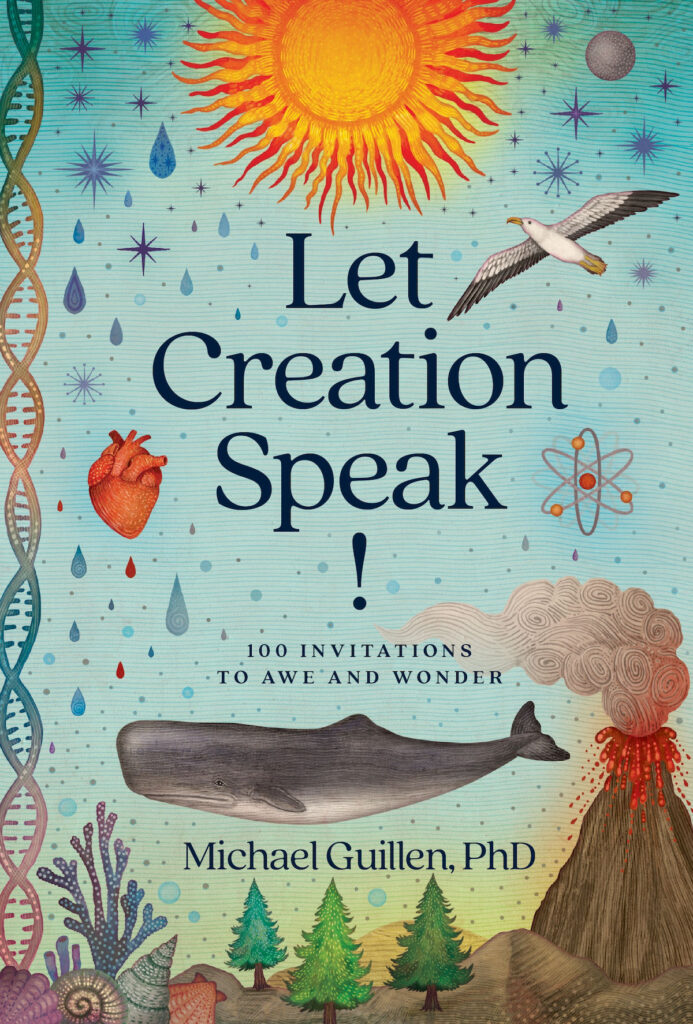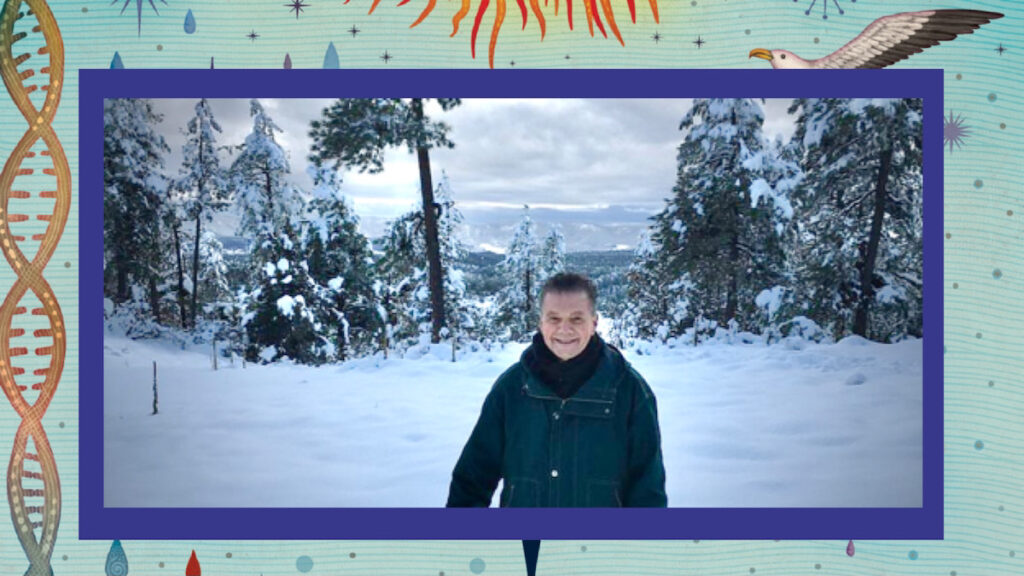A CONVERSATION WITH MICHAEL GUILLEN, PhD
Science and Christianity can live comfortably within you. When it comes to how we live in this world, minute by minute, consider this: when we let creation speak to us and listen closely, we can address the tough questions with things much bigger than science – wisdom, passion, and action guided by God.
Disney’s Circle Of Life in the beautifully animated movie, The Lion King, is heartwarming. As The Reading Tub explains, “From a spiritual standpoint, the Circle of Life signifies the eternal nature of the soul and its journey through various incarnations. This cycle continues until the soul has learned the lessons necessary for its growth and evolution, ultimately achieving a state of spiritual enlightenment or liberation.” Heartwarming? Yes. Scientific? Not at all. You may not have realized this but science reinforces, in fact is based on, the Christian worldview of creation – a linear process with Christ at the center. Scientist, Michael Guillen, PhD, explains that in his Science + God podcast. (We’ve include it below. Listen to it.)
In his book, Let Creation Speak!, Guillen says, “Everything around us is striking evidence that God exists – the he once appeared in human form, spoke to us directly and made us for a specific purpose. In this Shout! OUTDOOR LIFESTYLE MAGAZINE conversation with him he will inspire your purpose to let creation speak to your spirit, be in awe of God’s creation and worship the Creator. As we do that, THEN we can care for creation, help sustain it for future generations as God intends and steward a climate that bear’s the thumbprint of God’s very nature by continually changing.
WATCH AND LISTEN THEN PURSUE – EXPLORE – CELEBRATE
READ IT DAILY – LET GOD CAPTIVATE YOU
From three-time Emmy Award winner, bestselling author, and former ABC News science editor Dr. Michael Guillen, comes Let Creation Speak!, a book of fascinating and inspiring daily essays that explore the astonishing scientific facts about the universe in a fresh new way, including these topics:
- The infinite size of the universe
- Unusual numbers we see in nature
- A sperm whale’s super-powerful voice
- Symbiotic relationships that make coral beds possible
- The wily, carnivorous Venus flytrap
- The bird with the longest wingspan–the wandering albatross
Let Creation Speak! is a 100-day adventure designed to rescue you from the monotony and smallness of everyday life. To change you, radically and permanently. Journey alongside Dr. Guillen and starting right now let God and his creation speak directly to you!

START READING SELECTED BOOK EXCERPTS
Use the ORDER NOW button above to get copies of the book shipped to you and your friends. Then expand the 2 selected book excerpts below. In our video conversation with Mr. Guillen he shares about 4 of the 100 stories in his book. Of those 4, we’ve included 2 of those stories here for you to read. Adapted from Let Creation Speak! by Michael Guillen, PhD. Copyright © 2023. Used by permission of Tyndale House Publishers, a Division of Tyndale House Ministries. All rights reserved.

Tap/click here to expand and read this book excerpt. Tap/click again to collapse.
Invitation 39
Unplumbed Depths
Deep beneath south-central Kentucky is the world’s longest cave system, appropriately named Mammoth Cave National Park. With its many miles of subterranean tunnels, pits, and caverns, it is larger than the world’s next two biggest cave systems combined.
Mammoth is famous for its long, tube-shaped corridors that we believe were carved by underground rivers that have since subsided. Explorers have christened these corridors with names such as Boone Avenue, Cleveland Avenue, and Kentucky Avenue.
Mammoth Cave is an example of what we call a solution cave. Such caves are gradually eaten out of the underground limestone rock by an acidic solution of rainwater and carbon dioxide, which the rainwater absorbs from the air and soil it traverses.
American explorers discovered Mammoth in the late 1700s, after which many enslaved men became particularly well acquainted with its labyrinthian twists and turns while mining saltpeter there. In fact, nineteenth-century slaves are credited with mapping many of Mammoth’s corridors and for guiding visitors through them.
But long before all that—roughly four thousand years ago—Native Americans knew all about Mammoth. In its seemingly endless chambers, we’ve discovered their footprints, bits of their clothing, remnants of the torches they used to navigate the cave, and even the perfectly mummified body of one native who was crushed beneath a huge rock while mining the cave’s ubiquitous gypsum crystals.
But even long before Native Americans existed, the native wildlife knew all about Mammoth. Today, it is home to 130 species of animals and insects, some of which are unique to the cave—for instance, the eyeless Kentucky cave shrimp (Palaemonias ganteri). It doesn’t have eyes, because none are needed in the absolute, eternal blackness of Mammoth’s vast, underground realm.
To date we’ve carefully mapped out more than four hundred miles of the sprawling cave system. But some experts believe there are still hundreds of miles more waiting to be plumbed.
Reflection
According to the Bible’s description of God, he is vast—far more so than Mammoth Cave. In fact, God is even bigger than infinity.
On a practical level, that means, among other things, that you and I will never fully comprehend him—physically, intellectually, or emotionally. It’s a huge mistake, therefore, to second-guess God.
Yet many people do just that. All the time.
You often hear them complain, “If there’s a God, then how come . . . ?”
What they’re really saying is, “If I were God, then things would be different.”
But you and I are not God, so we’ll never know what it’s like to be him. To claim otherwise—to boast, “If I were God, then things would be different”—is delusional, never mind blasphemous.
According to the Bible, you are able to have a personal relationship with the bigger-than-infinite creator of the universe. But don’t let that go to your head. Always remember your place. He is God; you are not.
Even after a lifetime of studying the nuances of God’s words and exploring his natural creation; even after staying constantly in touch with him through prayer; even after putting him first all your life—you will have plumbed only the tiniest part of God’s immeasurable being.
The Creator Speaks
Oh, how great are God’s riches and wisdom and knowledge! How impossible it is for us to understand his decisions and his ways!
For who can know the Lord’s thoughts?
Who knows enough to give him advice?
Romans 11:33-34, nlt

Tap/click here to expand this book excerpt. Tap/click again to collapse.
Invitation 95
Bigger than You
The Great Barrier Reef—the largest living structure on Earth—is officially one of the Seven Natural Wonders of the World. Comprising 2,900 individual reefs and 900 islands, it spans 130,000 square miles—big enough to be seen with the naked eye from the moon!
The Great Barrier Reef’s skeleton is made of calcium carbonate, the rock-hard substance in eggshells and pearls. It has been created over many, many years by billions of polyps, creatures related to jellyfishes and anemones and no bigger than a grain of sand. Decorating the hard skeleton, like so many tiny shrubs, are a wide variety of soft corals.
Altogether, the Great Barrier Reef is a magnificent kaleidoscope of six hundred kinds of coral, with wonderful names such as the organ pipe coral (Tubipora musica), smooth cauliflower coral (Stylophora pistillata), and finger coral (Montipora digitata). It’s also home to some thirty species of whales, dolphins, and porpoises; six species of sea turtles; 215 species of birds; and 1,500 fish species.
The Great Barrier Reef is a dazzling metropolis pulsing with life day and night. A remarkable study in how wildly diverse organisms can live together in perfect harmony.
Reflection
We humans are social creatures; we don’t like being alone, which is why we place recalcitrant prisoners in solitary confinement. But our being social creatures spells both good news and bad news.
First, the bad news.
Our sociability brings us together, but our conflicting agendas inevitably create disagreements. Disagreements steadily tear away at whatever unity we might have had, until it all falls apart.
But there is good news, as well.
On those wonderful occasions when we all band together for a common cause, we’re able to achieve monumental results—results that no person working alone could possibly accomplish.
We see this all the time in construction. People with vastly different backgrounds—from college-trained architects to wealthy investors to middle-class vendors to blue-collar workers—all come together to build something spectacular, like the Taj Mahal, the Brooklyn Bridge, or the Notre Dame Cathedral—structures that require multiple generations and disciplines to complete.
Next time you come together with others for a common purpose, great or small, call to mind the example of the Great Barrier Reef. Set aside your ego and your differences with other group members, and work hard for unity, so you can increase the odds of being part of something truly magnificent and long-lasting.
The Creator Speaks
A kingdom divided by civil war will collapse. Similarly, a family splintered by feuding will fall apart.
Mark 3:24-25, nlt
I appeal to you, dear brothers and sisters . . . live in harmony with each other. Let there be no divisions. . . . Rather, be of one mind, united in thought and purpose.
1 Corinthians 1:10, nlt
LISTEN TO DR. MICHAEL GUILLEN’S SCIENCE + GOD PODCAST
Use this graphic in your social media to share this feature story with your friends and family. Post a comment below so that you can engage with other readers and contribute to this conversation.





